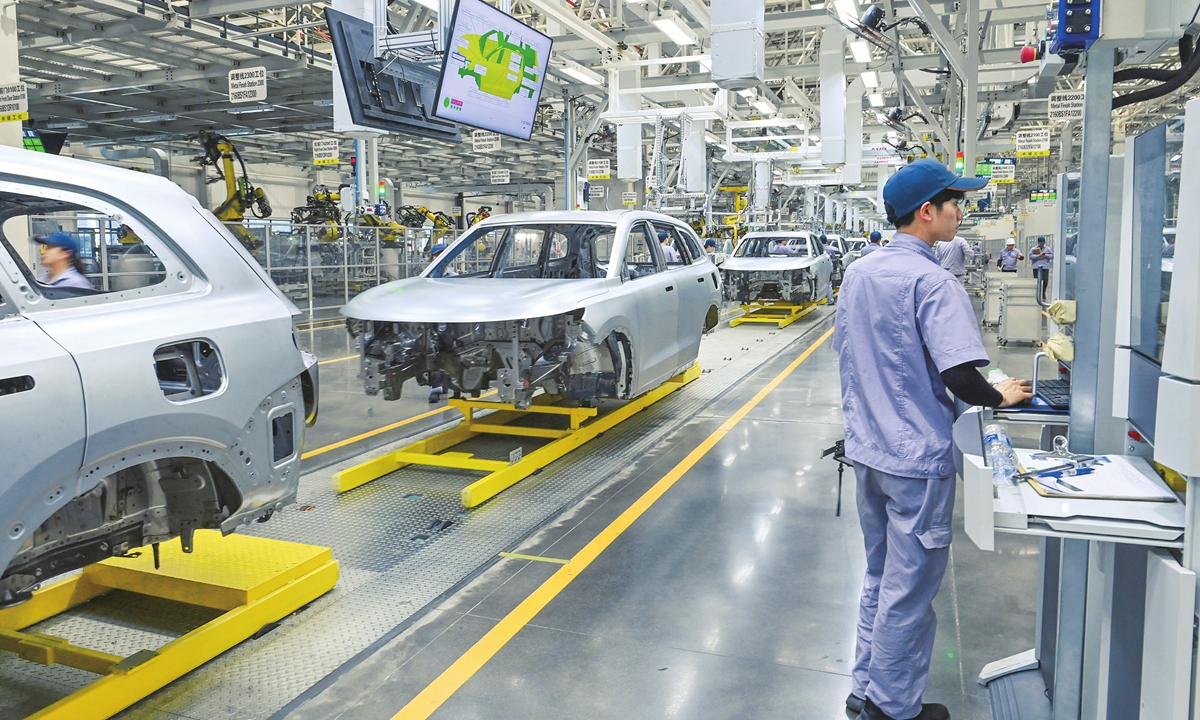
The manufacturing line of a NEV factory in Southwest China's Chongqing Municipality Photo: VCG
China's official manufacturing purchasing managers' index (PMI) returned to expansion range in March after running below 50 for five consecutive months, the National Bureau of Statistics (NBS) said on Sunday, as manufacturing activity increased with the fast resumption of work and production following the Spring Festival holidays.
The figure, although partly driven by the seasonal factor, showed that the economic recovery has further consolidated, highlighting the resilience of the Chinese economy, experts said, and they are more confident about GDP growth in the first quarter.
In March, the manufacturing PMI came in at 50.8 amid an increase in market activity, up from 49.1 a month earlier, returning to expansion territory.
The manufacturing sector has seen a recovery of production and strong market demand, with the production sub-index reaching 52.2 in March, up 2.4 points from the previous month, while the new orders index surged to 53.0.
Driven by strong demand, the purchasing volume index was reported at 52.7, an increase of 4.7 points, according to the survey.
Manufacturing activities expanded in March with the rapid resumption of work and production after the Spring Festival holidays, as the sector showed a significant expansion in business conditions, according to NBS senior statistician Zhao Qinghe.
In the survey of 21 industrial lines, 15 returned to expansion territory, an increase of 10 from the previous month, said Zhao.
Zhang Liqun, an analyst at the China Federation of Logistics and Purchasing, said that the significant rebound of the manufacturing sector and the PMI surge above the expansion-contraction line of 50 was not only driven by seasonal factors, but also provided further verification of the positive development trend of China's economic recovery.
The sub-index for production and operation activity increased by 1.4 points, indicating that business confidence has largely recovered, and the effects of pro-growth policies aimed at stabilizing growth and boosting confidence since the beginning of the year began to see results, Zhang said.
Experts believe the return of the PMI to the expansion range shows that China's economy is bottoming out and rebounding, and economic growth was substantial in the first quarter.
With the PMI reaching 50.8 and other indicators such as fixed-asset investment and retail sales rising, China's economy showed signs of recovery in the first quarter, Cao Heping, an economist at Peking University, told the Global Times on Sunday.
"The GDP growth rate could have reached 5.2 percent in the first quarter, which is quite optimistic, " Cao said.
While welcoming the growth in the PMI, it is also important to focus on the transition of China's economy from quantity growth to quality improvement, experts said.
The PMI rebound won't be overly rapid, as the economy is transitioning from quantitative expansion to qualitative improvement, with the continuous optimization of the economic structure. Quality enhancement is more important for China's economy than total volume increase, Cao noted.
China has been the world's top manufacturing hub for 14 consecutive years. The authorities have implemented pro-growth policies to accelerate manufacturing output, paving the way for high-quality development.
It's necessary to further refine and implement the mapped-out stimulus measures - such as promoting a new round of large-scale renewal of manufacturing equipment and trade-ins of cars and home appliances - to provide strong support for the high-quality development of the manufacturing sector, Zhao said.
On March 14, the State Council, the cabinet, released a plan to promote the large-scale renewal of equipment and the trade-in of durable consumer goods, opening up a huge market worth trillions of yuan. The action plan is aimed at bringing more high-quality durable consumer goods into people's lives, smoothing the recycling chain of resources, and significantly improving the quality and level of economic circulation.



